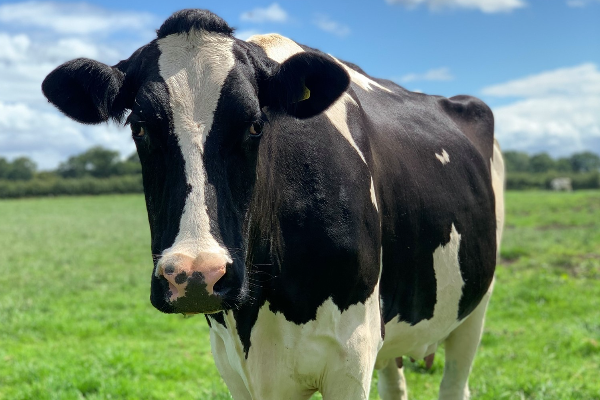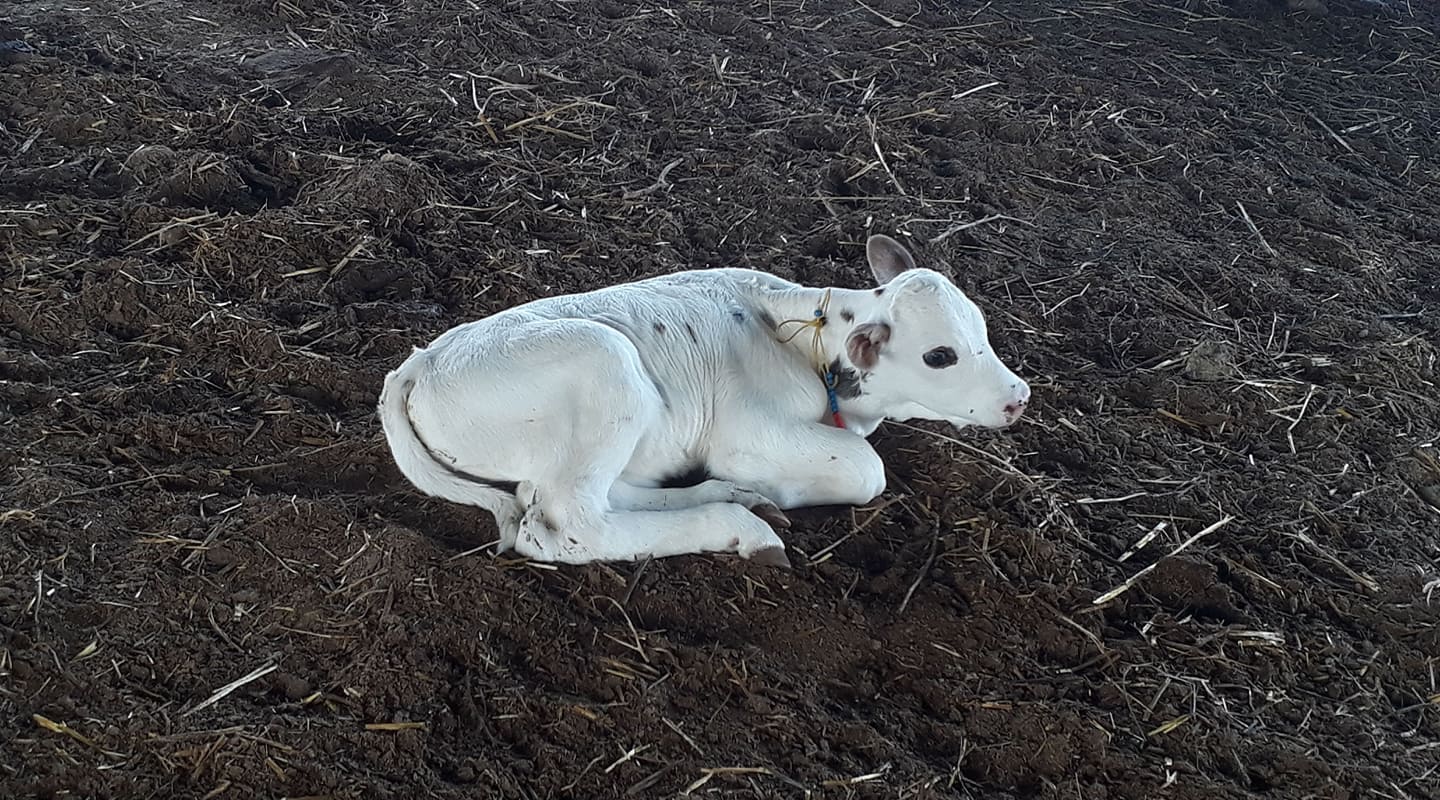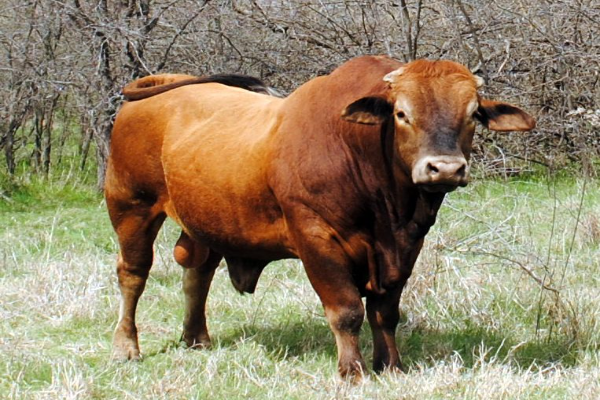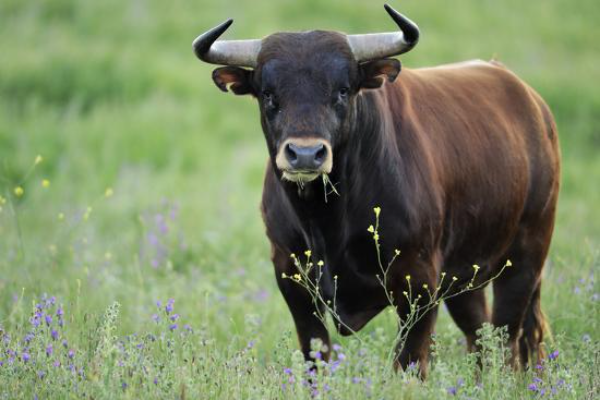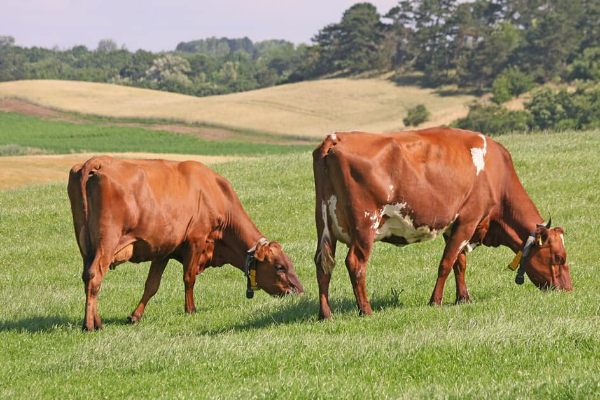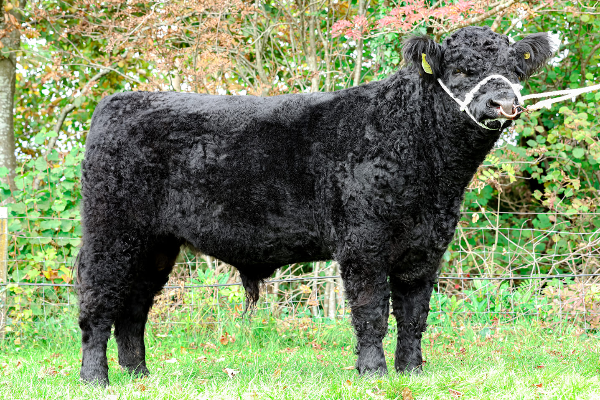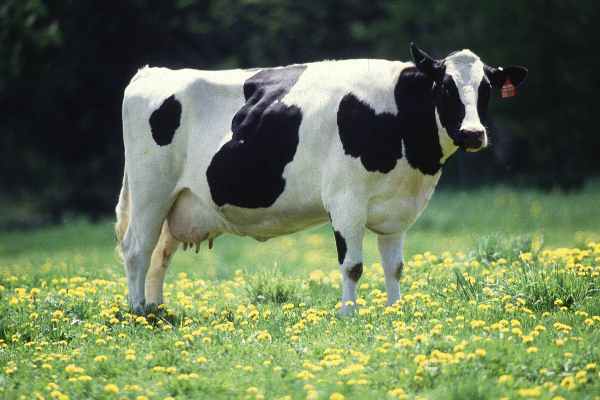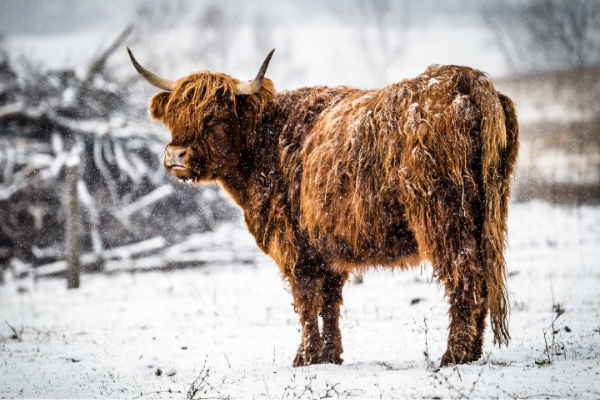Holstein Friesian Cattle
Holstein Friesian Cattle (often shortened to Holstein in North America, while the term Friesian is often used in the UK and Ireland) are a breed of dairy cattle originating from the Dutch provinces of North Holland and Friesland, and Schleswig-Holstein in Northern Germany.
These cattle are believed to have been selected for dairy qualities for about 2,000 years. They have long been widely distributed over the more fertile lowlands of Continental Europe, where they are valued highly for their milk-producing ability.
They are known as the world's highest-production dairy animals. Its chief characteristics are its large size and black and white spotted markings, sharply defined rather than blended. Holstein cattle are most quickly recognized by their distinctive color markings and outstanding milk production.
The Dutch and German breeders bred and
oversaw the development of the breed with the goal of obtaining animals that
could best use grass, the area's most abundant resource. Over the centuries,
the result was a high-producing, black-and-white dairy cow. Inbreeding was not tolerated, and (distinct)
families never arose, although differences in the soil in different localities
produced different sizes and variations.
The Holstein-Friesian is the most widespread cattle breed in the world. They can now be found on every continent and in almost every country. This breed is present in more than 150 countries.
The breed is widely distributed but usually is concentrated in areas having good fluid milk markets. With the emphasis on the production of lean beef, the Friesian either as a purebred or crossed with a beef bull is playing an increasingly important part in beef production in Great Britain and the United States.
What Is
The History Of Holstein
Friesian Cattle?
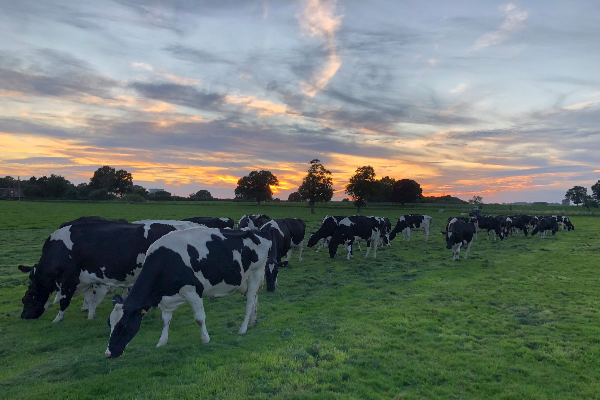
In 1985, there were eleven million dairy cows in the USA, nine million of which were Holstein. In Canada, Holsteins made up 95% of the dairy breeds. Since then, however, the dairy cattle industry has declined sharply.
Europe
With the growth of the New World, markets began to develop for milk
in North America and South America, and dairy breeders turned to The Netherlands for their livestock. After about 8,800 Friesians (black
pied Germans) had been imported, disease problems in Europe led to the
cessation of exports to markets abroad.
In Europe, the breed is used for milk in the north and meat in the south. Since 1945, European national development has led to cattle breeding and dairy products becoming increasingly regionalized. More than 80% of dairy production is north of a line joining Bordeaux and Venice, which also has more than 60% of the total cattle.
This
change led to the need for specialized animals for dairy (and beef) production.
Until this time, milk and beef had been produced from dual-purpose animals. The
breeds, national derivatives of the Dutch Friesian, had become very different
animals from those developed by breeders in the United States, who used
Holsteins only for dairy production.
Breeders imported specialized dairy Holsteins from the United States to cross with the European black and whites. For this reason, in modern usage, "Holstein" is used to describe North or South American stock and its use in Europe, particularly in the North.
"Friesian" denotes animals of traditional European ancestry, bred for both dairy and beef use. Crosses between the two are described by the term "Holstein-Friesian".
United Kingdom
Holstein-Friesians were found throughout the rich lowlands of the Netherlands, northwestern provinces of Germany, Belgium and northern France. The breed did not become established in Great Britain at the time, nor was it used in the islands of Jersey or of Guernsey, which bred their own special cattle named after the islands.
Their laws prohibited using imports from the continent
for breeding purposes. After World War II, breeders on the islands needed to
restore their breeds, which had been severely reduced during the war and
imported almost 200 animals. Canadian breeders sent a gift of three yearling bulls to help establish the breed.
The pure Holstein Breed Society was started in 1946 in Great Britain, following the British Friesian Cattle Society. The breed was developed slowly up to the 1970s, after which there was an explosion in its popularity, and additional animals were imported. More recently, the two societies merged in 1999 to establish Holstein UK.
United States Of America
Black and white cattle from Europe were introduced into the US from 1621 to 1664. The eastern part of New Netherland (modern-day New York and Connecticut), where many Dutch farmers settled along the Hudson and Mohawk River valleys.
They probably brought cattle with them from their native land and crossed them with cattle purchased in the colony. For many years afterward, the cattle here were called Dutch cattle and were renowned for their milking qualities.
The first recorded imports were more than 100 years later, consisting of six cows and two bulls. These were sent in 1795 by the Holland Land Company, which then owned large tracts in New York, to their agent, Mr. John Lincklaen of Cazenovia.
A settler described them thus,
"The cows were of the size of oxen, their colors clear black and white in
large patches; very handsome".
In 1810, a bull and two cows were imported by the Hon. William Jarvis for his farm at Wethersfield, Vermont. About the year 1825, another importation was made by Herman Le Roy, a part of which was sent into the Genesee River valley.
The rest were kept
near New York City. Still later, an importation was made
into Delaware. No records were kept of the
descendants of these cattle. Their blood was mingled and lost in that of the
native cattle.
The first permanent introduction of this breed was due to the perseverance of Hon. Winthrop W. Chenery, of Belmont, Massachusetts. The animals of his first two importations, and their offspring, were destroyed by the government in Massachusetts because of a contagious disease. He made a third importation in 1861.
This was followed in 1867 by importation for the Hon. Gerrit S. Miller, of Peterboro, New York, made by his
brother, Dudley Miller, who had been attending the noted agricultural school at
Eldena, Prussia, where this breed was highly regarded.
These two importations, by Hon. William A. Russell, of Lawrence, Mass., and
three animals from East Friesland, imported by Gen. William S. Tilton of
the National Military Asylum, Togus, Maine, formed the nucleus of the Holstein
Herd Book.
After about 8,800 Holsteins had been
imported, a cattle disease broke out in Europe and importation ceased.
In the late 19th century, there was
enough interest among Friesian breeders to form associations to record
pedigrees and maintain herd books. These associations merged in 1885, to found
the Holstein-Friesian Association of America. In 1994, the name was changed to
Holstein Association USA, Inc.
In the United States, the Holstein-Friesians outnumber all other dairy breeds and produce nine-tenths of the milk supply. The milk, however, has a relatively low butterfat content. Holstein dairy cattle dominate this country's milk production industry.
The reason for
their popularity is clear: unexcelled production, greater income over feed
costs, unequaled genetic merit, and adaptability to a wide range of environmental
conditions. Added up, this means more profit for the dairy producer who milks
Holsteins. This point becomes even clearer when you consider that nine of every
10 dairy producers currently milk Holsteins.
What About Red And White Holsteins?
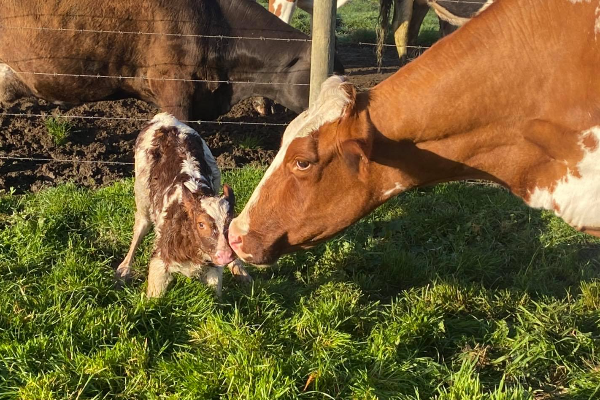
The expression of red color replacing the black in Holsteins is a function of a recessive gene. Assuming the allele 'B' stands for the dominant black and 'b' for the recessive red, cattle with the paired genes 'BB', 'Bb', or 'bB' would be black and white, while 'bb' cattle would be red and white.
Earlier 13th-century records show cattle of "broken" colors entered the Netherlands from Central Europe. Most foundation stock in the US was imported between 1869 and 1885.
A group of early breeders decreed that animals of any color other than black and white would not be accepted in the herd book and that the breed would be known as Holsteins. There were objections, saying that quality and not color should be the aim and that the cattle should be called "Dutch" rather than Holsteins.
Only a small number of carriers were identified over the hundred-year span from the early importations until they were accepted into the Canadian and American herd books in 1969 and 1970, respectively.
Most of the early accounts of red calves being born to black and
white parents were never documented. A few stories of "reds" born to
elite parents persist over time, as there is a tendency to credit the ancestor
with the highest relationship to a red-carrier animal as the one that
transmitted the trait, whereas sometimes it is the other parental line that has
passed it on, even though the ancestor responsible may have entered the
pedigree several generations earlier.
In 1952, a sire in artificial
insemination (AI)
unit in the US was a carrier of red coat color. Although the AI unit reported
the condition and advised breeders as to its mode of inheritance, almost a
third of the breeding unit's Holstein inseminations that year were to that
red-carrier bull. That year, American AI units had used 67 red-factor bulls
that had sired 8250 registered progeny. In spite of this, any change to the
color marking rules was rejected.
The Red and White Dairy Cattle Association (RWDCA) began registry procedures in 1964 in the United States. Its first members were Milking Shorthorn breeders, who wanted a dairy registry for the cattle they had bred in prior years, including some red and white Holsteins.
When Milking Shorthorn breeders were looking for
potential outcrossing individuals to improve milk
production, red and white Holsteins came into the picture since the red color the factor is the same for both breeds. The RWDCA had adopted an "open herd
book" policy, and the Red and White Holstein became the major player.
The red trait was thus able to survive the attempts to eradicate it that came from all sides of the Holstein industry. It was inevitable that even when a red calf was culled, the herd owner rarely did anything to remove the dam from his herd and only hoped she would not have another red calf.
Many red calves,
born in both countries prior to the 1970s, were quietly disposed of, with a
view to preserving the acceptance of their elite pedigrees.
Also, thousands of Holsteins were imported from Canada each year, and many were carriers. More than 14,000 Holsteins were exported to the United States in 1964 and again in 1965. This was at a time when both countries were debating the "red question".
While the United States was trying to eliminate the red trait, the Canadian imports simply counterbalanced the US effort to reduce its incidence.
Canada's number one red-carrier sire in the 1940s was A.B.C. Reflection Sovereign. His sons and grandsons in the 1950s and '60s spread the red gene throughout Canada and increased its frequency in the United States.
Three other big names siring Red and Whites in the United States were Rosafe Citation R, Roeland Reflection Sovereign, and Chambric A.B.C. The red trait was readily available in Canadian Holstein genetics.
Early on, there was criticism of the policy of the Canadian AI units to remove bulls found to carry red. A number of superior bulls were slaughtered or exported. The studs were simply supporting the Canadian policy to prevent the intensification of the red recessive in the breed.
The phrase "carries the red factor" had to be included in the
description, and excessive promotion of unproven red-factor bulls was
discouraged. They later added the aim of permitting intelligent breeders to use
any red-carrier sire that had an outstanding proof for production and type.
It became obvious that AI was the primary way of finding out which bulls were red carriers. Prior to AI, few red-carrier sires were uncovered because their service was limited to one or a few herds.
Such herds often had no carrier females, and there was only a 25% chance that a carrier bull mated to a carrier female would produce a red calf.
If a red and white calf were dropped, it was often concealed and quietly
removed from the herd.
In 1964, the Netherlands Herd Book Society indicated a breakdown of 71% Black and White Friesian and 28% Red and Whites. A herdbook that accepted Red and Whites had already been established in the United States.
A separate herd book for Canadian Red and Whites was then
established, following which Red and Whites became acceptable to the major
Canadian markets. The sales ring began to establish an interest in the new breed.
The US Holstein-Friesian Association and its membership worked diligently from its early days until 1970 to eliminate the red trait from the registered population. However, once the door was open, red and whites began to appear in some of the more elite herds.
The rush to get
the best of Canadian breeding even prior to the opening of the herd book
brought red calves to many dairymen who had never even seen one.
Canadian Red and Whites became eligible
for registration in the herd book on July 1, 1969, through an alternate
registry. Red and Whites were to be listed with the suffix –RED and Black and
Whites with ineligible markings would be registered with the suffix –ALT. Both
groups and their progeny would be listed only in the Alternate book and the
suffixes had to be part of the name. In the Canadian herd books, all –Alt and
-Red animals were listed in the regular herd book in registration number order
and were identified with an A in front of their numbers. The Alternates were
separate in name only. The A in front of the registration number was
discontinued in 1976 and the –Alt suffix was dropped in 1980, but –Red was
continued. It did not bar the registration of animals whose hair turned from
red to black.
The US Holstein Association decided not to
have a separate herd book for red and whites and off-color animals. The
suffixes of –Red and –OC would be used, and numbering would be consecutive. The
first red and white Holsteins were recorded with an R in front of their
numbers. 212 males and 1191 females were recorded in the initial group of red
registrations. Red and Whites registered in the Canadian herdbook numbered 281
in 1969 and 243 in 1970.
An American Breeders Service ad in the Canadian Holstein Journal in 1974 on Hanover-Hill Triple Threat mentioned one of several color variants that were not a true red. Its existence was undoubtedly common knowledge among breeders in both countries, but until that time, it had not been mentioned in print. Calves were born red and white and registered as such, but over the first six months of age turned black or mostly black with some reddish hairs down the backline, around the muzzle, and at the poll.
The hair coat color change became known as Black/Red and sometimes as Telstar/Red since the condition appeared in calves sired by Roybrook Telstar. Telstar was the sire of Triple Threat, but nothing about this had hitherto been in print about Telstar, which was by then over 10 years old.
Black/Reds were often discriminated against when sold and were barred from Red and White-sponsored shows. In 1984, Holstein Canada considered recoding B/R bulls that had always been coded simply as red carriers, a designation that was not acceptable to all buyers.
The breed agreed to change after checking with other breed associations and with the AI industry. In 1987, Holstein Canada and the Canadian AI industry modified their coding procedures to distinguish between Black/Red and true red color patterns for bulls. Holstein Canada dropped the suffix Red as a part of the name in 1990, but continued to carry it as part of the birth date and other codes field.
What Are
The Characteristics Of Holstein
Friesian Cattle?
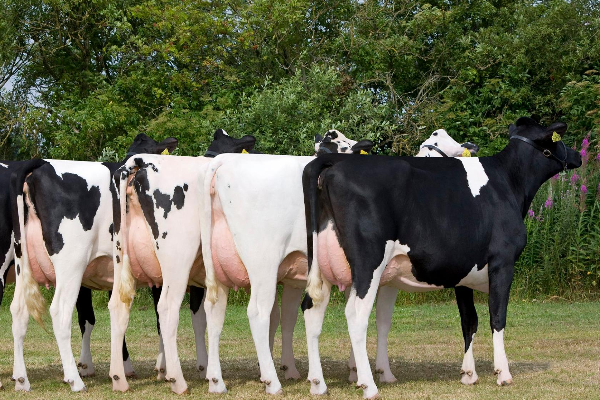
- Holsteins have distinctive markings, usually black and white or red and white in color, typically exhibiting a piebald pattern. On rare occasions, some have both black and red coloring with white.
- The red factor causes this unique coloring. 'Blue' is also a known color. This color is produced by white hair mixed with the black hairs giving the cow a bluish tint. This coloring is also known as 'blue roan' in some farm circles.
- Average production for all Holsteins enrolled in official U.S. production-testing programs in 1987 was 17,408 pounds of milk, 632 pounds of butterfat, and 550 pounds of protein per year. There is growing interest in the polled factor in dairy cattle.
- All breeds have some polled (naturally hornless) cattle. A number of Red & White breeders have shown a special interest in developing polled cattle. A large number of polled young sires, both red and red factor are currently in sampling.
- Top producing Holsteins milked three times a day have been known to produce over 72,000 pounds of milk in 365 days.
- Holsteins have the highest milk productions in the world. They have an unequaled genetically anchored achievement ability that has no biological ceiling. Genetic improvements of 1 to 2 percent per year are totally realistic.
- They adapt to all management and utilization systems. They can be stabled, but are equally suitable for grazing. They can be kept on grassland or in mixed farming systems with bi-annual grazing, or be stabled throughout the year.
- Neither does it matter whether they are kept in the high-lying or low-lying areas. Not only are Holstein suitable for low-cost farming systems, but they are also eminently suitable as dairy industry cows in intensive farming, which requires the stabling of cows.
- However, Holsteins, compared to natural breeds, are not as resistant to heat and diseases when in difficult agro-ecological areas. Their reaction to such conditions is reduced production capacity.
- Experience has taught that they exhibit divergent adaptation abilities, which should therefore receive attention from a technical point of view when breeding. In the case of cross-breeding with natural breeds, the calves show a higher heat tolerance, and higher production figures are achieved than in the case of cross-breeding with other cultural breeds.
- Holsteins produce vigorous calves distinguished by rapid growth, early maturity, and easy care. If they are managed well, they exhibit no fertility problems.
- They are good-natured, are easy to handle, and can be stabled without any problems. They are also resistant to stress, exhibit a herd mentality, and are not solitary animals.
- Holsteins are more than just a dairy breed. The animal also contributes to the meat supply worldwide, have a high growth percentage in the fattening sector, and produces meat with fine fiber.
- In industries aimed exclusively at milk production, they are cross-bred with beef breeds for a better quality veal.
- While some cows may live considerably longer, the normal productive life of a Holstein is six years.
What Is the Weight
Of Holstein Friesian Cattle?
The Holstein cow is about 150-160 cm high at the withers, weighing approximately 800-900 kg; bulls are 170-180 cm in height and weigh 1,000-1,250 kg, and sometimes up to 1,500 kg.
Holstein heifers should be bred by 11 to 14 months of age when they weigh 317–340 kg (700–750 lb) or 55% of adult weight. Holstein's calves weigh 80 to100 pounds when born.
Sources
http://www.thecattlesite.com
http://www.holsteinusa.com
https://www.britannica.com
https://www.masterrind.com
http://www.cattlenetwork.net
http://afs.okstate.edu
https://en.wikipedia.org
Find a BreederMore

Written by
Researcher Ghost Writer
EditorBreedsMore
IllnessesMore
Forage cropsMore
![]() Патологическая физиология голодания Arina TARAN
Патологическая физиология голодания Arina TARAN![]() Дефицит фосфора (гипофосфатемия) Hipofosfatemi Arina TARAN
Дефицит фосфора (гипофосфатемия) Hipofosfatemi Arina TARAN![]() Какие бывают кормораздатчики для ферм КРС? Irina Makarova
Какие бывают кормораздатчики для ферм КРС? Irina Makarova![]() Кормушки для овец Diana Myakisheva
Кормушки для овец Diana Myakisheva![]() Питание домашних коз: что едят, виды корма и правила кормления Alina Arslantürk
Питание домашних коз: что едят, виды корма и правила кормления Alina Arslantürk![]() Важность минералов питании сельскохозяйственных животных Irina Makarova
Важность минералов питании сельскохозяйственных животных Irina Makarova

